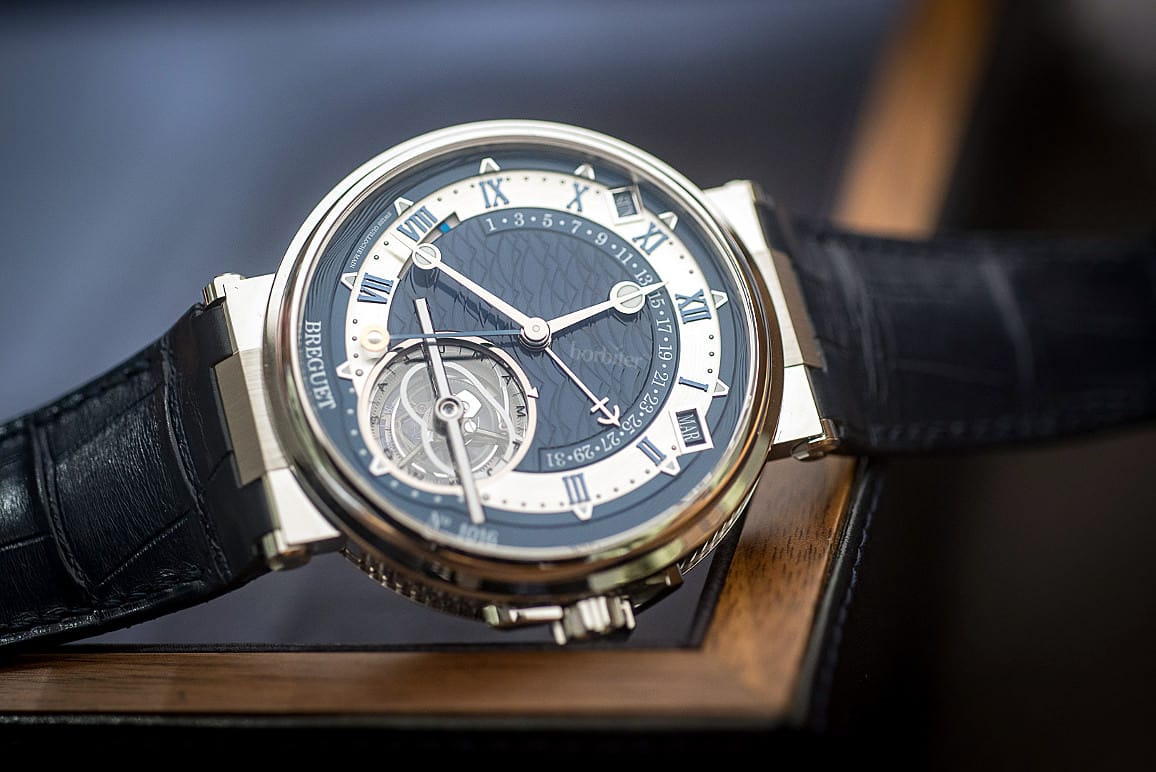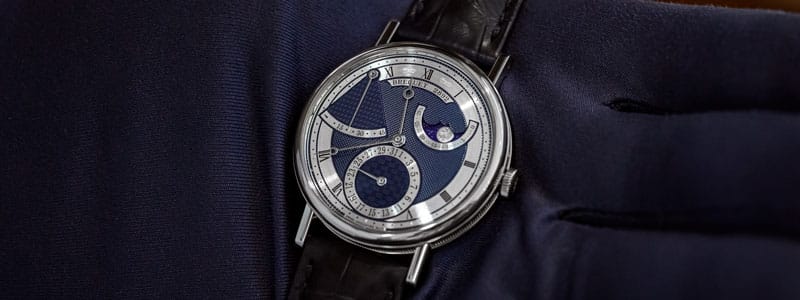Table of Contents
Abraham-Louis Breguet, the greatest watchmaker of all time.
Talking about a Breguet watch is always a great honor. Its neoclassical style used to impress and still does, mainly for its elegance and originality; let’s take, for instance, the hands and numbers that bear the manufacturer’s name on them and which are also used nowadays by several of the most prestigious contemporary maisons. And what about the secretly signed dials, introduced already in 1795, hand-crafted using the guillochè technique (1786) and then covered in silver, or the classic groove that is engraved on the case-back of the manufacturer’s watches?
 It is not only the style of the great “Master” that needs to be remembered and celebrated, but also his many inventions, such as the half–moon winding automatic movement that equipped the 1780 pocket–watches or the “Pendule Sympatique” that used to recharge the pocket-watches inserted on top of a pendulum. The continuous enhancements of the escapements from the past led Breguet to the creation of his most famous invention; the Breguet spiral, followed by the creation of the Tourbillon (1801) that was crafted to improve the chronometric performance of the watches that were (and are) being affected by the earth’s gravitational field. We could go on and on and also talk about the sound spring for the Minute Repeaters; a stainless steel blade wrapped around the movement that reduces the size of the case and also improves the sound quality. Another creation is also the shock–proof device called “parachute” that is still being used today on (and is also the style hallmark of) the models of the Tradition collection.
It is not only the style of the great “Master” that needs to be remembered and celebrated, but also his many inventions, such as the half–moon winding automatic movement that equipped the 1780 pocket–watches or the “Pendule Sympatique” that used to recharge the pocket-watches inserted on top of a pendulum. The continuous enhancements of the escapements from the past led Breguet to the creation of his most famous invention; the Breguet spiral, followed by the creation of the Tourbillon (1801) that was crafted to improve the chronometric performance of the watches that were (and are) being affected by the earth’s gravitational field. We could go on and on and also talk about the sound spring for the Minute Repeaters; a stainless steel blade wrapped around the movement that reduces the size of the case and also improves the sound quality. Another creation is also the shock–proof device called “parachute” that is still being used today on (and is also the style hallmark of) the models of the Tradition collection.
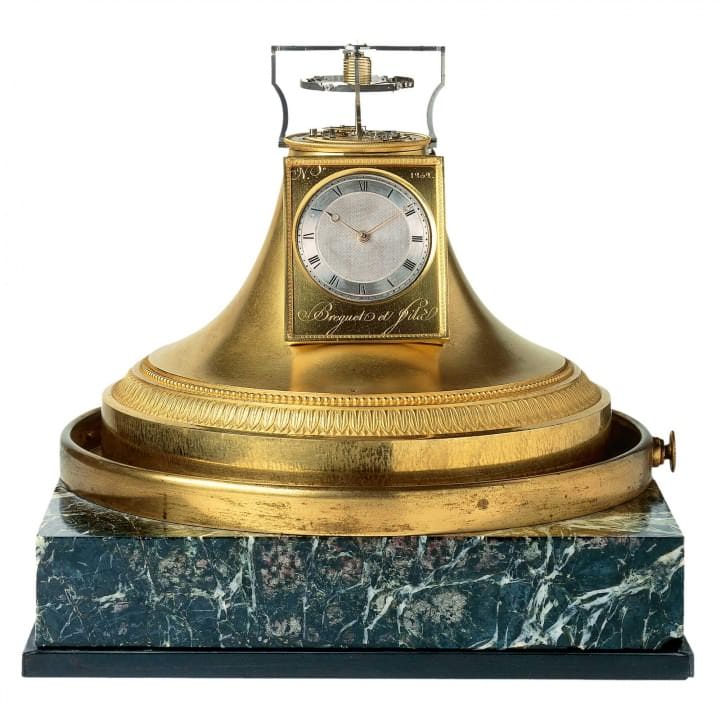
Thanks to all the skills demonstrated in his creation, Breguet was appointed a member of the “Bureau des Longitudes” in 1814; a prestigious institution made up of astronomers and sailors that turned the “Master” into a reference person for everything related to the calculations and measurements of the sea longitude. The sea chronometer was invented by John Harrison (1693 – 1776) and was and still is one of the greatest inventions of all time because it allows overcoming the calculation of the longitude at sea even in situations when the modern GPS devices installed on ships should stop working.
Practically speaking, the chronometer is placed on the reference time of the Greenwich Meridian, which, added or subtracted to the local 12 o’clock time determined with the aid of the sextant, allows the user to calculate a precise point of their route, even when located in the middle of the sea. To thank Breguet for his invention that allowed users to calculate the longitude at sea, King Louis XVIII awarded him the official title of “Horloger de la Marine Royal” on October 27th, 1815. This title was, at that time, the highest title a watchmaker could ever wish for, and, as if that were not enough already, Breguet also joined the Academy of Sciences, where he received, again off the hands of King Louis XVIII, the “Légion d’honneur” title.
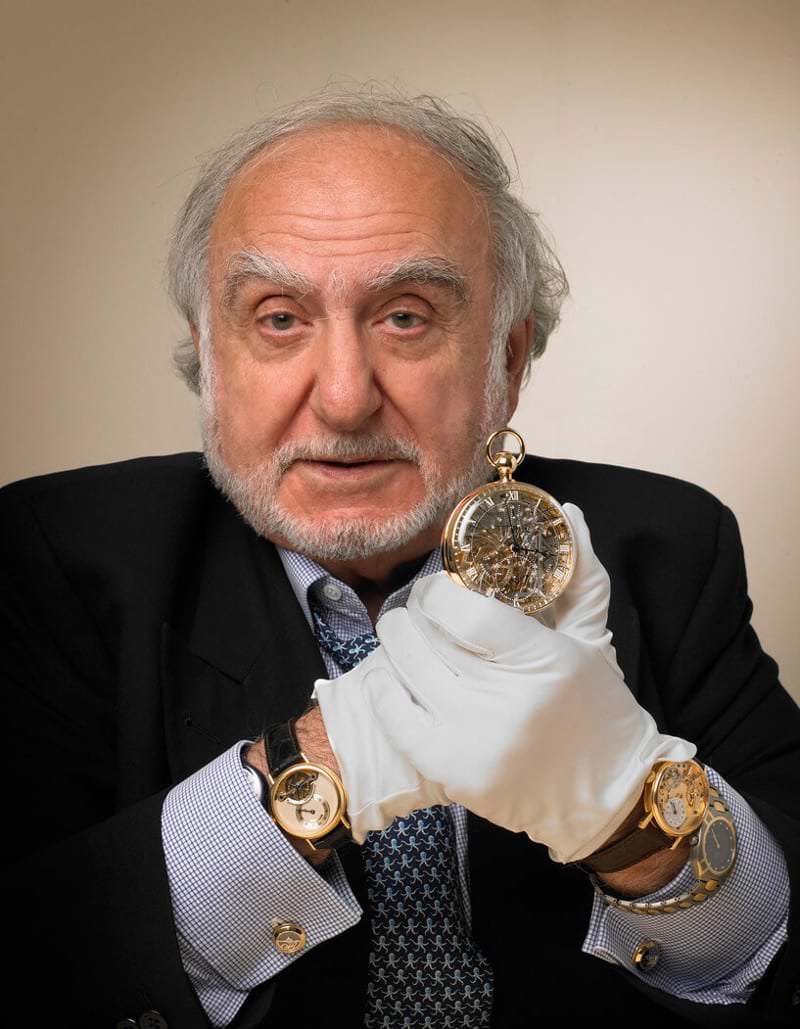 Among all of the 18 brands pertaining to the Swatch Group, Breguet was the favorite of the “grand patron” Nicholas George Hayek (1928 – 2010) who, thanks to his big love for this manufactory with a rich history and thanks to the big investments made, managed to take the company, after the 1999 acquisition, to a glorious new beginning, while still keeping its distinctive characteristics. This new start has brought with it innovation through the use of new modern technologies that are worthy of the great Abraham Louis Breguet: the silicon–made escapement’s anchor wheel for example, the patented magnetic pin of the balance wheel’s shaft that makes it more stable and shock-resistant.
Among all of the 18 brands pertaining to the Swatch Group, Breguet was the favorite of the “grand patron” Nicholas George Hayek (1928 – 2010) who, thanks to his big love for this manufactory with a rich history and thanks to the big investments made, managed to take the company, after the 1999 acquisition, to a glorious new beginning, while still keeping its distinctive characteristics. This new start has brought with it innovation through the use of new modern technologies that are worthy of the great Abraham Louis Breguet: the silicon–made escapement’s anchor wheel for example, the patented magnetic pin of the balance wheel’s shaft that makes it more stable and shock-resistant.
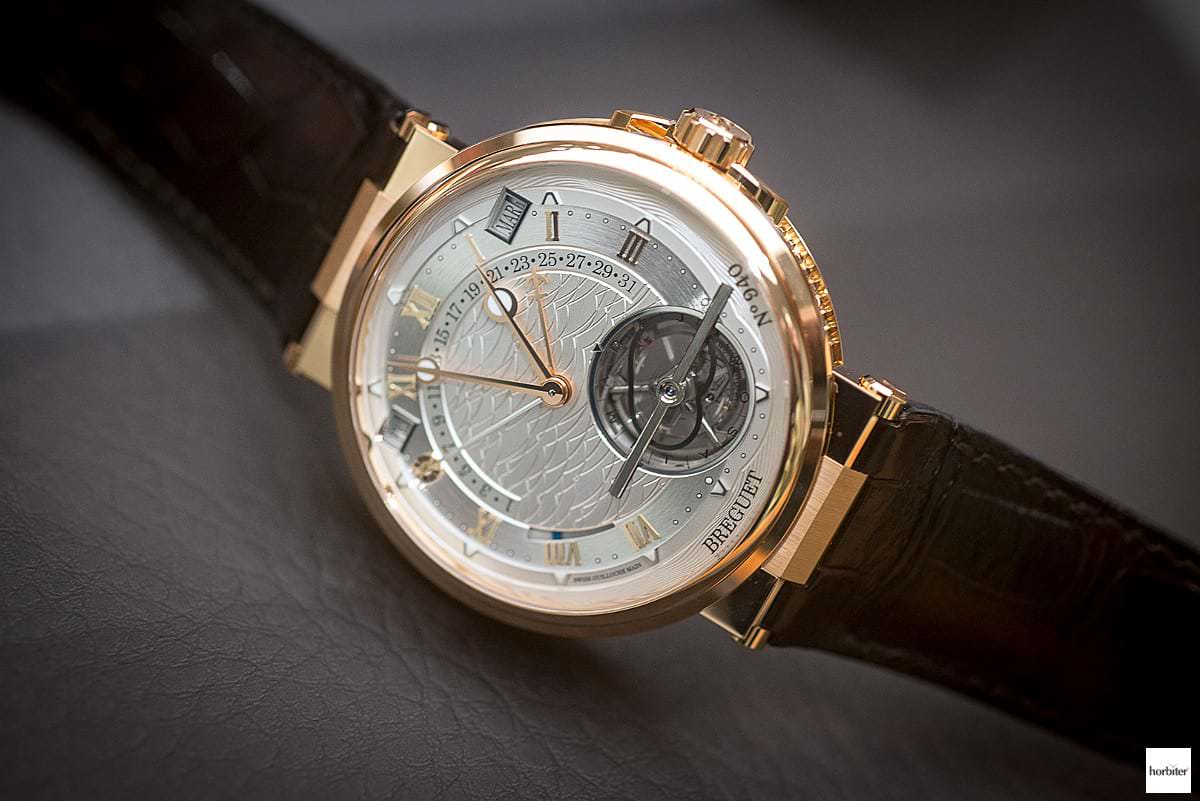 There is also the revolutionary magnetic regulator integrated within the chime mechanism that completely eliminates, if compared to the friction regulator, both noises and wear and tear; this regulator equips the musical 7800 model all the way up to those models with the escapement running at a 10Hz frequency, the Type XXII models or the Classique Chronometrie (reference 7727). The regulator guarantees incredible precision results not only due to the high frequency of the movement, but also due to the presence of the silicon escapement and the titanium balance wheel.
There is also the revolutionary magnetic regulator integrated within the chime mechanism that completely eliminates, if compared to the friction regulator, both noises and wear and tear; this regulator equips the musical 7800 model all the way up to those models with the escapement running at a 10Hz frequency, the Type XXII models or the Classique Chronometrie (reference 7727). The regulator guarantees incredible precision results not only due to the high frequency of the movement, but also due to the presence of the silicon escapement and the titanium balance wheel.
The umpteenth masterpiece: the Breguet Marine Equation Marchante 5887.
This year, at Baselworld, the maison presented a world exclusive that summarizes everything I wrote in my long introduction above: the Breguet Marine Equation Marchante 5887. This is a collection that takes its name from the prestigious title given to Breguet in 1815 by Louis XVIII (“Horologer de la Marine Royale”) for the invention of those useful sea chronometers that were vital at the time to calculate the position of ships. Since the world does not turn round but actually follows a very irregular orbit and its rotation axis is inclined by 23 degrees, true solar time can vary throughout the year and go from a maximum negative level (such as on 3rd November lasting 23h and 44min) to a maximum positive level (as on 12th February that lasts 12h14min) if compared to the conventionally used local time. Four days a year (on 16th April, 14th June, 1st September, and 25th December) true local solar time and average local time match.
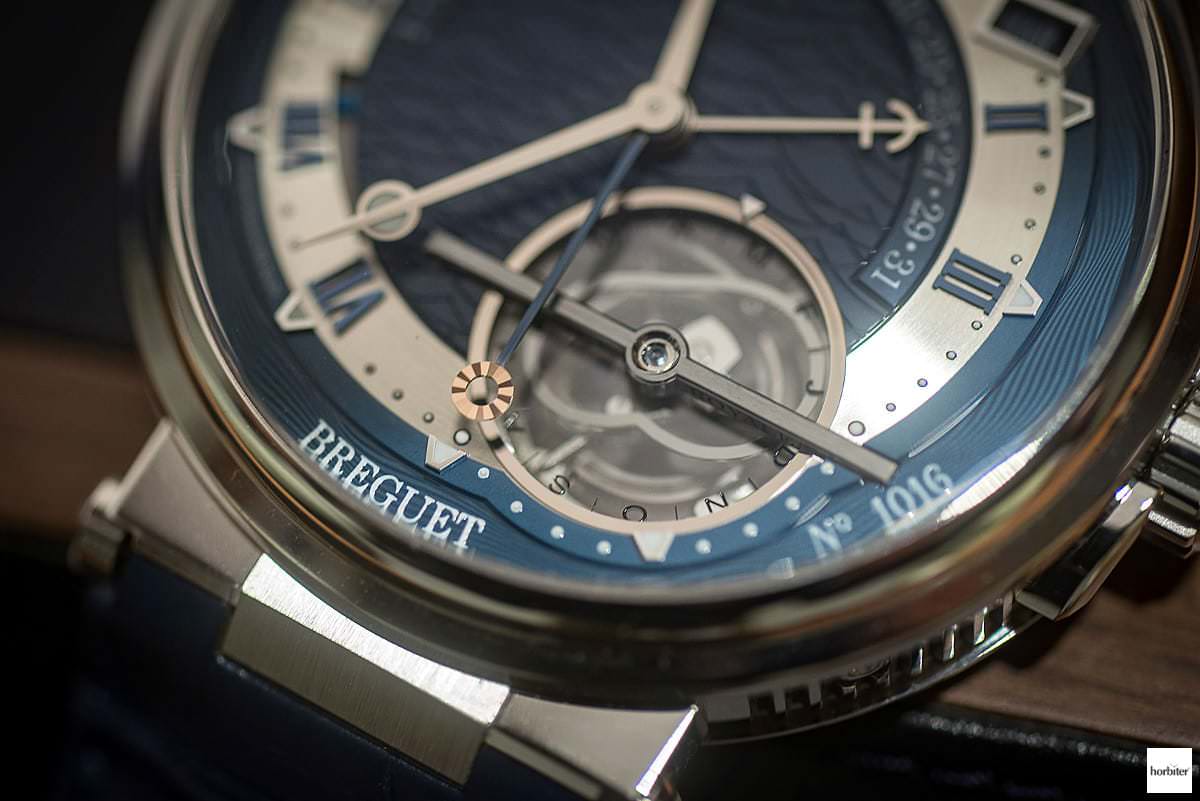 The second hand of the marching equation, this fascinating and complex indication, was exclusively placed on large or pocket-watches, while it was indicated by a simpler months scale on wrist watches, where values ranging from plus to minus would appear. In 1991, Breguet invented and patented a movement on the classic and thin reference 3740BA model that was made of yellow gold; the movement featured a perpetual calendar and an equation with an automatic correction feature that could last for over a century and that also included a separate indicator located between 1 o’clock and 2 o’clock, which was used to calculate the difference between local solar time and local time.
The second hand of the marching equation, this fascinating and complex indication, was exclusively placed on large or pocket-watches, while it was indicated by a simpler months scale on wrist watches, where values ranging from plus to minus would appear. In 1991, Breguet invented and patented a movement on the classic and thin reference 3740BA model that was made of yellow gold; the movement featured a perpetual calendar and an equation with an automatic correction feature that could last for over a century and that also included a separate indicator located between 1 o’clock and 2 o’clock, which was used to calculate the difference between local solar time and local time.
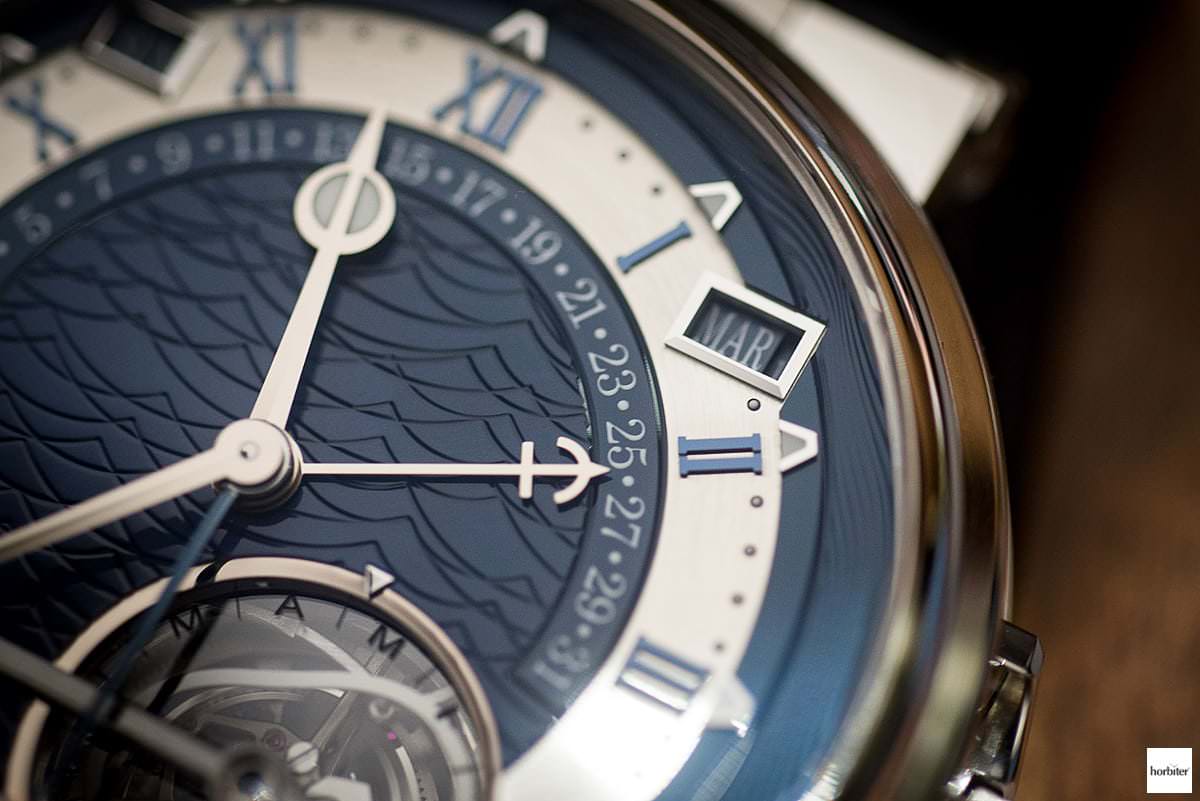 The Breguet Marine Equation Marchante 5887 is of a completely different kind: it features a case that looks more modern, it sports a more spaced groove and a central attachment. The timepiece also features a surmounted “B” crown with alternated shiny and matted surfaces, the case is quite generous in size and measures 43.9mm, it is waterproof up to a depth of 100m, it is made of 950 platinum and it sports a blue dial. There is also a 18kt rose gold version with a silver dial, an exclusive (for this model) wavy pattern. It is even more advanced because it has a separate minutes hand that runs on the dial with a faceted sun; each day, this hand indicates the true solar time by moving away by a variable value that depends on the time of the year, along with the minutes hand of the local time.
The Breguet Marine Equation Marchante 5887 is of a completely different kind: it features a case that looks more modern, it sports a more spaced groove and a central attachment. The timepiece also features a surmounted “B” crown with alternated shiny and matted surfaces, the case is quite generous in size and measures 43.9mm, it is waterproof up to a depth of 100m, it is made of 950 platinum and it sports a blue dial. There is also a 18kt rose gold version with a silver dial, an exclusive (for this model) wavy pattern. It is even more advanced because it has a separate minutes hand that runs on the dial with a faceted sun; each day, this hand indicates the true solar time by moving away by a variable value that depends on the time of the year, along with the minutes hand of the local time.
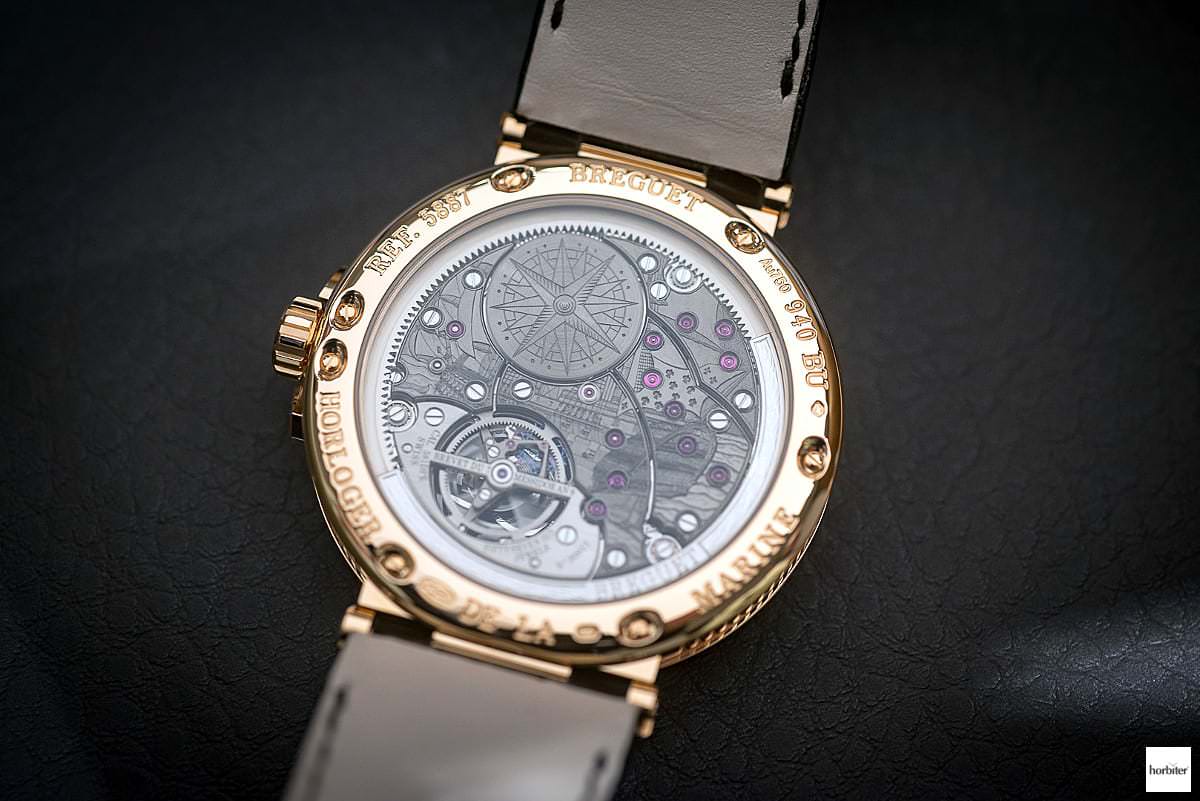 This complication can be programmed through a special cam (built in a “bean shape” or an “eight shape“) that is precise because the celestial events of the sun in the sky always take place on the same dates, thanks to a probe coupled to the equation of the time lever. This cam is very thin and is supported by a transparent sapphire disk with the months depicted on it, which can be used to correct the equation of time.
This complication can be programmed through a special cam (built in a “bean shape” or an “eight shape“) that is precise because the celestial events of the sun in the sky always take place on the same dates, thanks to a probe coupled to the equation of the time lever. This cam is very thin and is supported by a transparent sapphire disk with the months depicted on it, which can be used to correct the equation of time.
Obviously, this complication is supported by a perpetual calendar with two small windows located at 10 o’clock and at 11 o’clock that indicate the days of the week. At 1 o’clock and at 2 o’clock are the months and the leap year. The date is indicated through a hand built in the shape of a 180° retrograde anchor made of white gold on the platinum version; the hand is made of rose gold on the other version and is hosted within the two small windows. Between 7 o’clock and 8:15 lies the 80 hour power reserve (did you notice the peripheral winding rotor?) that is located under the “Swiss guilloche main” writing.
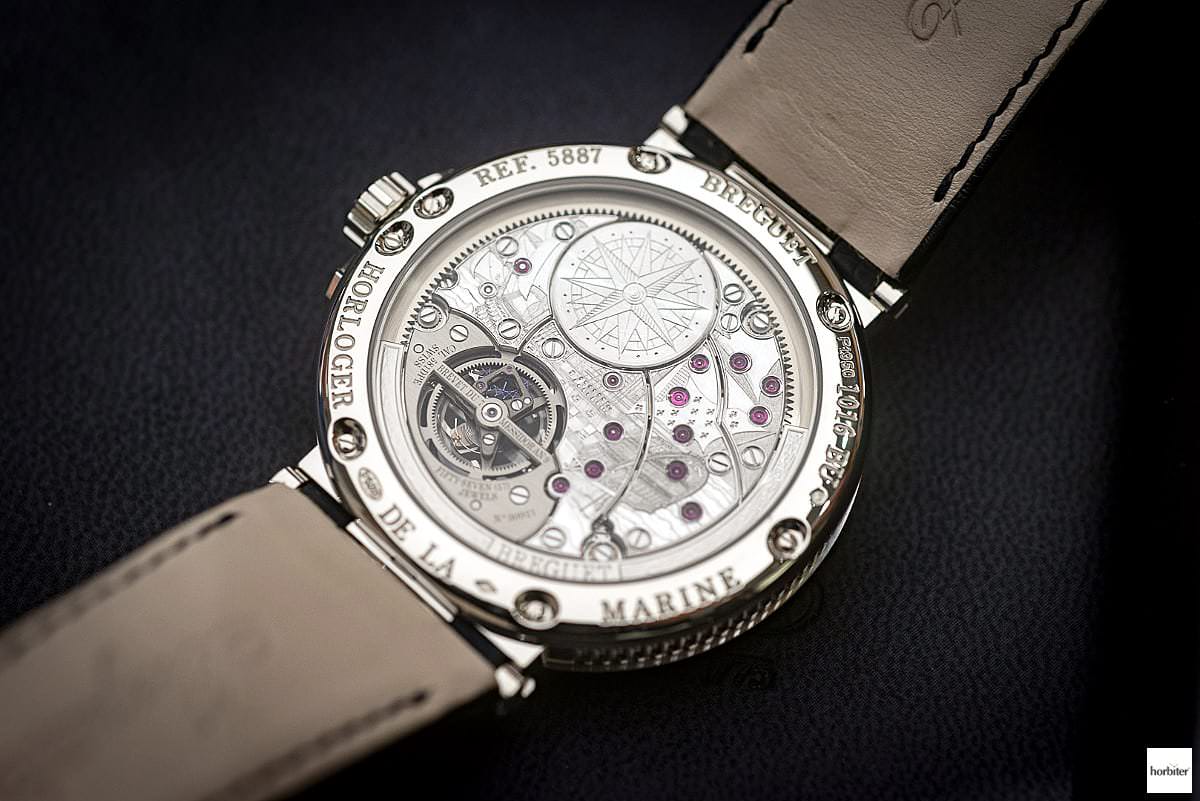 As if the above was not enough already, there is a 60 second Tourbillon located between 4 o’clock and 6 o’clock, the Tourbillon features a titanium cage that “navigates” at a frequency of 4Hz. The upper bridge is engraved and it sports the “Marine Royale” writing on it, the silicon balance spring with the disc and the cam of the time equation. The hours and minutes hands on the Breguet Marine Equation Marchante 5887 are crafted in the typical Breguet style and they are luminescent, same thing for the small dots that appear on the matted perimeter and the Roman numerals surmounted by luminescent trapezoid shaped indexes.
As if the above was not enough already, there is a 60 second Tourbillon located between 4 o’clock and 6 o’clock, the Tourbillon features a titanium cage that “navigates” at a frequency of 4Hz. The upper bridge is engraved and it sports the “Marine Royale” writing on it, the silicon balance spring with the disc and the cam of the time equation. The hours and minutes hands on the Breguet Marine Equation Marchante 5887 are crafted in the typical Breguet style and they are luminescent, same thing for the small dots that appear on the matted perimeter and the Roman numerals surmounted by luminescent trapezoid shaped indexes.
If you turn the watch, you can see the case-back that has been secured with screws and a sapphire glass through which you can view the beautiful movement with 57 rubies with a “découverte” finish. This finish, coupled with the deep bevel, enhances the ruby and can “capture” the spilled oil. Among other components are the finely chiseled bridges that depict the “Royal Louis” vessel, the winding barrel that depicts the wind rose, and the Tourbillon bridge with its engraved “brevet du 7 messidor an 9” engraving; a reference to the date the republican calendar that used to be used back then was patented (26th June 1801). This gorgeous watch is matched with an alligator leather strap with a deploying pin buckle.
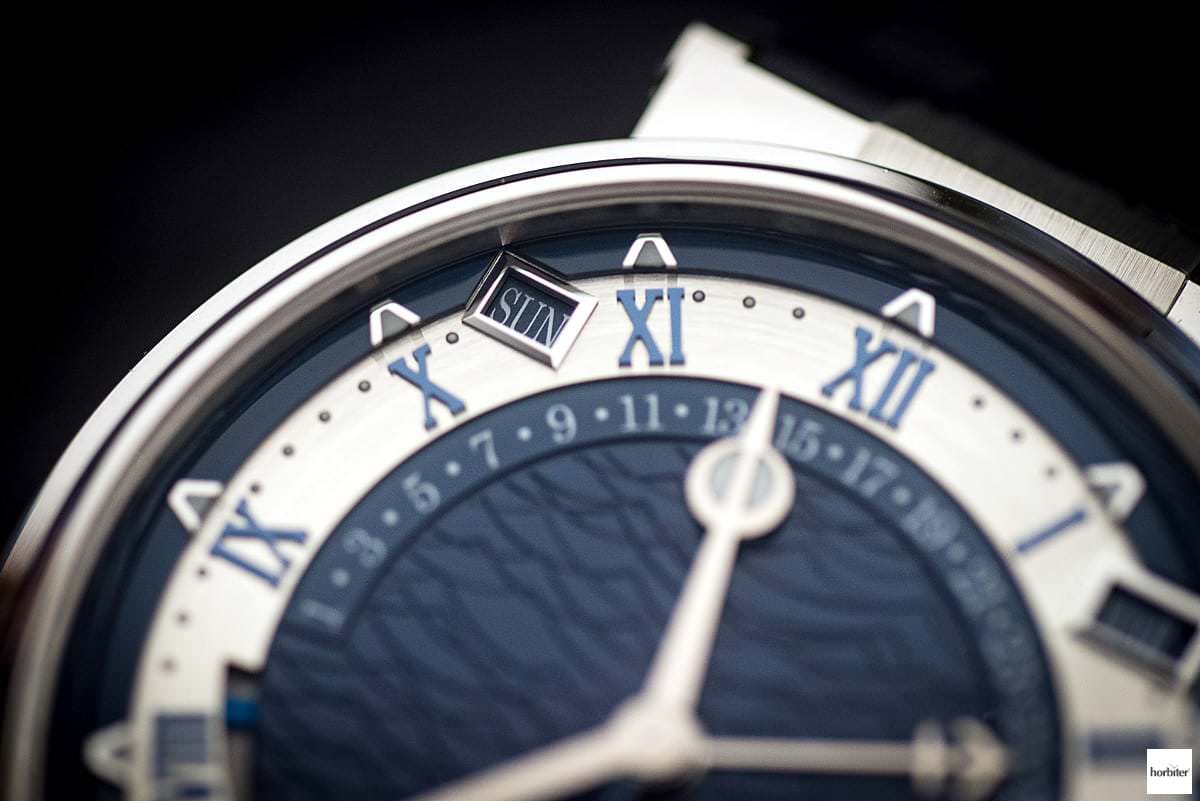 Talking about retail prices of the Breguet Marine Equation Marchante 5887 doesn’t come easy when you deal with timepieces of such a high level; the retail price is quite high and it totals 227,700 euros for the platinum version and 212,500 euros for the rose gold version. Obviously, if you consider the blazon of this brand, the “rare” complication with its artisanal finishing blended with modern technology; I reckon that the retail price is quite appropriate to the timepiece’s features. I would like to incorporate the dead beat seconds function also, so that it is even more in line with the old sea chronometers.
Talking about retail prices of the Breguet Marine Equation Marchante 5887 doesn’t come easy when you deal with timepieces of such a high level; the retail price is quite high and it totals 227,700 euros for the platinum version and 212,500 euros for the rose gold version. Obviously, if you consider the blazon of this brand, the “rare” complication with its artisanal finishing blended with modern technology; I reckon that the retail price is quite appropriate to the timepiece’s features. I would like to incorporate the dead beat seconds function also, so that it is even more in line with the old sea chronometers.
(Photo credit: Breguet, Horbiter®)
Denis Fabbro @Horbiter®

